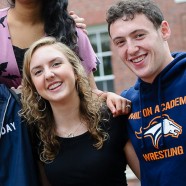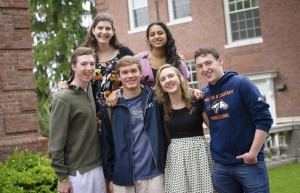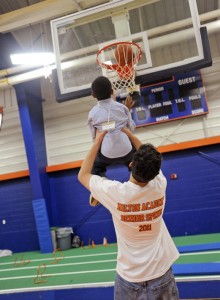
At Milton, community service is a choice, not a requirement. Students say this makes the commitment more meaningful. Every week more than 250 students use their free periods to volunteer in over 30 different organizations in the Greater Boston area. Students travel in small groups to tutor in local schools and centers, visit elderly in assisted living homes, and work with disabled children and adults. Some students return to the same placement year after year. We spoke to six of these students about their experiences—the challenges, the surprises and the lifelong influences.
“Community service is an important way to spend my time,” says Mallika Iyer, ’13. “Getting caught up in your own cycle of homework, sports and other activities is easy. I was worried about losing perspective, being too focused on my own advancement. Community service keeps me level-headed; I see how other people live their lives. Giving someone your time is really invaluable. Even if I can’t fix everything, investing my time and focusing on somebody can make a difference.”
Two faculty members, Andrea Geyling and Heather Sugrue, lead the program, and an enthusiastic 18-member student board helps drive the program’s direction and student participation. Mallika and Josh Ellis ‘13 served as co-heads on the 2012–2013 student board. Josh says their role included delegating tasks, coordinating service sites, liaising with those sites and running weekly board meetings.
 Students decide to participate in community service for a variety of reasons and family influence is a strong force. “We are so lucky to go to this fantastic school,” says Arielle Ticho ’13. “My Jewish background teaches me to give back. My family uses the saying tikkun olam, which means ‘repairing the world.’ Community service felt like a natural extension to do that.”
Students decide to participate in community service for a variety of reasons and family influence is a strong force. “We are so lucky to go to this fantastic school,” says Arielle Ticho ’13. “My Jewish background teaches me to give back. My family uses the saying tikkun olam, which means ‘repairing the world.’ Community service felt like a natural extension to do that.”
For Josh, church trips to Haiti planted the seed for doing community service at Milton. “I started going to Haiti before the earthquake and I’ve now been there nine times. Every trip is life-changing. It’s a nice reality check on how I should appreciate everything and should live my life to the fullest.”
“When I was younger, my parents always encouraged my brothers and me to do community service and give back,” says Amanda Beaudoin ’13. “Now it’s me trying to get my family to do more. We do Walk for Hunger together every year. It is a good thing for our family to do and at the core of our family values.”
Students interested in considering service from an academic point of view can take History in Action for a Sustainable Society, an elective in the history and social sciences department. Coursework includes the weekly service commitment at a local site, along with readings, journaling, and class projects.
 “History in Action was the perfect class for me because we learned about social issues such as poverty, hunger, immigration and education,” says Arielle. “With each of those units, we traveled to sites. We went to two homeless shelters and also to speak with immigrants who are learning English. Connecting our class readings with reality makes issues more alive and closer.”
“History in Action was the perfect class for me because we learned about social issues such as poverty, hunger, immigration and education,” says Arielle. “With each of those units, we traveled to sites. We went to two homeless shelters and also to speak with immigrants who are learning English. Connecting our class readings with reality makes issues more alive and closer.”
The students say that every weekly visit is, itself, a learning experience. Amanda spent three years teaching art to first graders at the Taylor School, a public school in Boston.
“My first year around the holidays, there were student drawings of Santa hanging on the walls,” says Amanda. “There were black Santas, yellow Santas, white, green, blue. Most of my students were African-American and I should have expected they would draw Santa as African-American or a different appearance. But at first it seemed surprising to me that not everyone thinks of Santa as the old white man with the fat cheeks. Seeing the different perspectives they bring and how they interpret Santa however they want was amazing, just as they interpret each art project I lead. They taught me so much.”
Jesse Rice ’13 spent two years tutoring English at Mujeres Unitas, a center for Latina women. A big surprise for him was meeting a woman who had been living in the U.S. for five years without ever speaking English. “I couldn’t grasp, at first, how someone could get by here without speaking any English. I didn’t understand what some people, particularly immigrants, go through. In two years, I gained a much better perspective and understanding of the world around me.”
“One thing I didn’t expect was making strong friendships,” says Mallika. “I work with one girl who has Down syndrome. From a community service interaction, our relationship changed and we connected on a deeper level. We now consider each other good friends.”
Students often feel challenged in their service and in seeing the challenges where they worked.
“It’s hard, at first, to gain focus and ground the work you are doing,” says Josh. “You think you will be like Hilary Swank in the movie Freedom Writers and ‘save’ the kids. Over time you realize that small things matter. If you help one kid with a worksheet for 45 minutes, that helps that student and ultimately the class. The student board holds an annual feedback luncheon for all our volunteers where we discuss all kinds of issues. This one comes up a lot—volunteers have the challenge of focusing their work and applying it to their lives.”
For Jeremy Mittleman ’13, who worked at the Taylor School and also at a New York City summer enrichment program, the realities of city public school systems were eye-opening and sometimes despairing.
“It was incredible to see what a big deal testing is in the public schools and how stressful it is for the teachers. They have to find a balance between the testing and the learning. I’d never experienced that because I’ve always gone to private schools. It was also a shock to see the teachers buy their own materials, to see what the teachers go through day-to-day and sometimes the lack of support they feel. I came to understand the inequities in our society and why some kids aren’t graduating from high school.”
Each March, the Community Service Program sponsors a spring-break service trip. These trips take students, faculty and parents to places such as Belize, Navajo Land in Arizona and rural Appalachia.
“I had to motivate myself on the spring-break trip,” says Mallika. “I was used to more passive activities like teaching or working one-on-one with children. In Belize, we were doing manual labor, building learning spaces for the local school. It was about carrying bricks and using cement. We were interacting closely with the people who would use the school, so we wanted to give them something good. At the same time, the work was taxing. It made me appreciate the people who built and maintain the facilities we use everyday.”
Students who can’t make a weekly commitment get involved in other ways. At least 200 additional students participate in multi-annual events such as the Greater Boston Foodbank, Special Olympics tournaments, the Blood Drive and holiday giving events. The whole School participates in the annual Oxfam Hunger Banquet and the biennial Community Service Day. Each year, the program also supports individual and group initiatives for particular causes, such as earthquake relief in Haiti. The Hoops for Haiti event raised $10,000 the first year and has turned into an annual event that brings the whole School together.
Community service work has forged a path that some students will follow into college and the future.
“Starting junior year at the Taylor School, I knew I was interested in teaching but was not definite,” says Arielle. “But these past two years, I have been with those students every week. I loved it. Last summer, I worked with a professor of education doing research on inequities in education and how education connects to civic engagement. Now I plan to study education in college. I now know this is what I want to do and how I want to spend my life.”
“I want to be a doctor and work in Haiti regularly,” says Josh. “Doing community service made me realize that I can succeed academically and professionally and still give back in the way I want to give back. I tell new students that service is a tough commitment that demands a lot from you outside of the classroom, but once you get past that, it’s a great experience. It is cool to see students get interested in helping others in the middle of all the academic pressure. Community service does a good job of grounding us.”
–Liz Matson
Milton Replenishes the Food Bank's Late Winter Supply
Who Gave What? We set an ambitious goal of 100 percent participation for all Upper School students. Class representatives encouraged their classmates to get involved and kept track of participation in their respective grades. Students donated all sorts of nonperishable items—canned vegetables and fruit, peanut butter, jelly, cereal, pasta, rice and hygiene products. Students sorted their donations into bins in the Student Center—a visible manifestation of our progress. Because boarding students have less access to grocery stores, dorm faculty members were instrumental in our success, volunteering to bring students to buy items. In 2012, we collected more than 3,000 items. This year we lost count; food was literally overflowing from the bins. When we delivered our donations to the food pantry, however, the representative confirmed that we had surpassed last year’s donation.
From School to Tables: Delivery day is hectic, and the effort requires help from many people. Most of the SGA leadership dedicated their afternoon to loading cars with food and sorting at the food pantry. Many students and faculty outside of SGA got involved, as well. Seeing everyone work together during this event was so rewarding. The food drive helps all of us look beyond campus, beyond our daily lives at Milton, and recognize the importance of paying good fortune forward. At Milton we have everything we need at our fingertips, but many people living just minutes away have a very different experience. With this in mind, students in grades K–12 can work toward a common goal. No matter what our individual backgrounds or interests, everyone is involved in this experience. The annual food drive benefits not only families in the Town of Milton, but also our School. Our greatest reward was the reaction of those working at the food pantry. Food pantries often see a decrease in donations in the late-winter months, and we were able to replenish most of their supplies. This gratification energizes us, as leaders, and makes us want to do it all again. We hope that each pair of future head monitors recognizes the value of the food drive. While the work is significant, the rewards are tremendous.
–Jessica Li and Nick Maragos Class of 2013 Co-Head Monitors



